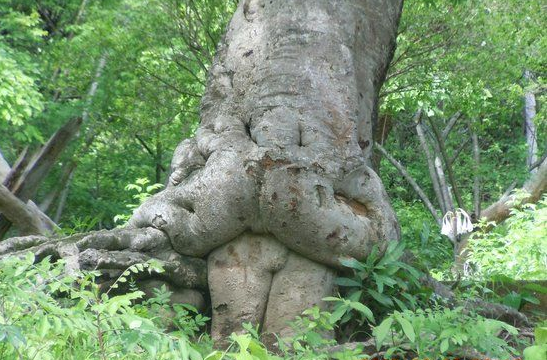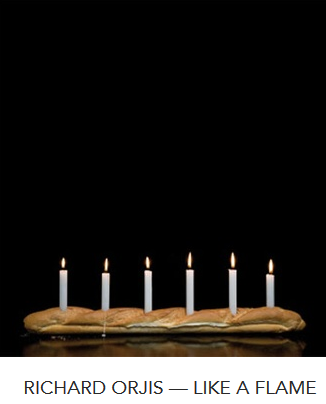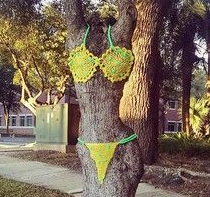Sex Academia-Style: Let’s All Have a Tree-some
The symposium was called ‘Hacking the Anthropocene’ and was no less goofy than its title suggests. A small sample concerned the mysterious topic of ‘bttming’, whose ‘methodology emerged out of a drifting conversation about glow worms, mushrooms and queer ecologies, tree hugging/humping, resting, composting and excretion, toilets and cruising’. There, now you know!
 Picture a climate-conscious Melbourne University arts graduate, Nancy, out of work and applying to stack shelves at Woolies.
Picture a climate-conscious Melbourne University arts graduate, Nancy, out of work and applying to stack shelves at Woolies.
Recruiter: Any special skills?
Nancy: Sure. I did a lot of inter-disciplinary study with the university’s flagship Sustainability Research Institute (MSSI).
Recruiter: Like what?
Nancy: Well, last July 8, I went to an all-day symposium on “Hacking the Anthropocene”. MSSI was an overall seed funder and major seminar sponsor, and one of the speakers was an authority on tree humping.
Recruiter: I see. What’s the “Anthropocene”?
Nancy: You really haven’t heard of the Climate Emergency and the Anthropocene? It’s “a name coined for the emerging geological era in which humans are centralised as the dominant planetary force. Perhaps intended to evoke ecological concern, it draws on settler colonial discourse, problematically homogenises all humans as planet destroyers and implies that we are locked into these petrifying ways of being.”
Recruiter: We might get back to you. This Wuhan Virus is keeping us pretty busy right now with the empty shelves. Thanks for dropping by.
Nancy’s interview was cut short before she could elaborate on that symposium with its “exciting schedule”, which featured a keynote talk on “Composting Feminism” (not a misprint).
This Do-It-Together symposium was booked out by eager academics and their students, some fretting on the waitlist. It was at the Abbotsford ex-Convent, with vegan morning tea and lunch and gender-neutral toilets. At least the morning tea wasn’t drunk from jam jars.[1] In each of three sessions, master Anthropocene Hackers described their hacks (example: “Rupturing the colonial Anthropocene”), and the audience got to “hack back”, a hip term for discussion. Some participants were “theys” rather than he or she.
MY EDITOR’S MEAL TICKET DEPENDS ON QUADRANT GETTING PLENTY OF CLICKS. PLEASE BE NICE AND TO REWARD HIS BRILLIANT EDITING, CLICK HERE.
The revelations were interleaved with “walkshops” where attendees “weathered with what-ever mid-Winter provides”, offset by raincoats and fleecy underwear. Those walkshops were about ‘Un-earthing. Wild concrete on living soil’, curated by visual ecologist Aviva Reed and celebrating “the sedimentation of our imaginations.”[2] Her walk notes are in need of Google Translate, but here goes:
Description: An ethereal moment of material molecular immersion into the living grounds we walk upon. Through this process we will unearth our obligations and responsibilities to care for the soil that cares for us … This walkshop engages critically and sensually with what is beneath our feet, honouring both the ingredients that make up the concrete pathways that hold us and the soil beneath … We name and acknowledge the sand, lime, silt and clay and through an immersive process will explore the deep time … asking what is our responsibility to honour the concrete for both its utilitarian and multi-specied complexity and our obligation to unearth the negations of this concrete for the soil beneath.
Celebrity guest was multi-tattooed and ripped Professor of Gender Studies Jack Halberstam of Columbia University, whose “work considers wild, queer, decolonial possibilities for protest culture, anarchy and performance.” Accidentally anticipating the Wuhan Flu, he spoke on “Strategies of Wildness – Why We Must Unbuild the World!”
He was currently working on a book titled Wild thing: Queer theory after nature which explores queer anarchy, performance and protest culture as well as the intersections between animality, the human and the environment. His prior books include “Skin Shows: Gothic Horror and the Technology of Monsters”, “Female Masculinity”, “The Queer Art of Failure” and “Gaga Feminism: Sex, Gender, and the End of Normal”. His articles include “What’s Queer About Queer Studies Now?” Who paid his airfares here, I wonder?
The Composting Feminism speaker was senior gender lecturer Dr Astrida Neimanis, who founded Hacking the Anthropocene in 2016. She hails from (you guessed it) Sydney University. Only last week she was writing about what bushfire smoke and Wuhan Flu “have to teach us about the politics and imaginaries of breathing in  contemporary societies? How do ‘we’ notice, engage with and respond to our gaseous (e.g. oxygen, carbon) and multispecies (e.g. eucalypts, viruses) relations and how might ‘we’ do this otherwise?” She would like to see you “reflecting on your own experiences of breathing over the last few months, and how this might be similar and different to human and non-human others.”
contemporary societies? How do ‘we’ notice, engage with and respond to our gaseous (e.g. oxygen, carbon) and multispecies (e.g. eucalypts, viruses) relations and how might ‘we’ do this otherwise?” She would like to see you “reflecting on your own experiences of breathing over the last few months, and how this might be similar and different to human and non-human others.”
Another talk was by artist Richard Orjis, of the Auckland University of Technology, on ‘bttming the Anthropocene’. One of his many artworks, ‘Like a Flame’, is reproduced at right to indicate where his muse leads him. As for “bttming”, there are no safe spaces at Quadrant,so think twice before hitting this explanatory link.
Orjis says, “Bttm Methodology emerged out of a drifting conversation about glow worms, mushrooms and queer ecologies, tree hugging/humping, resting, composting and excretion, toilets and cruising.”
As an unworldly reporter, I needed to consult Urban Dictionary to discover that actual “tree humping” may involve either sex with or domination of the phallic-like tree, often by exhibitionists. Here’s how it is used and defined:
Girl 2: Good thing he’s tree humping.
Platonic tree-hugging is a fetish practised by many green/climate academics. It was celebrated in a piece by Charles Sturt lecturer Shelby Gull Laird at the monoversity and taxpayer-funded (but anti-free speech) outlet The Conversation. “Are we all tree-huggers?” she asked. Her suggestions include “Spend some time sitting under a tree. And if you’re so inclined, maybe even give it a cuddle.”
The global arts community is not always into trees platonically. Minnesota’s Conceptual Artist Genevieve Belleveau, daughter of an environmental educator, has described her psychedelic drug-enhanced tree affairs, starting with a birch tree at age eight:
Fascination, and love, and the sense that the tree accepted my feelings—that even if she didn’t love me back, exactly, she was receptive to my love for her… kissing her and hugging her I felt a kind of shame afterwards, because I did that to a living entity without its consent … I don’t think it’s that bad that I humped the tree or whatever.”
For an award-winning Attenborough documentary on tree-humping, see here
 You’re probably thinking my interest in this lady’s arboreal love life is just prurient. No, because Ms Belleveau from far off Minnesota picked up on my Quadrant tribute to Melbourne’s Ecosexual Bathhouse in 2016, run by Perth’s Pony Express with $80,000 tax and ratepayer funding.[3] The Bathhouse, like the MSSI-backed symposium, offered a route for surviving the Anthropocene from the “devastating forces unleashed by global capital”. Among the Bathhouse’s attractive dances were
You’re probably thinking my interest in this lady’s arboreal love life is just prurient. No, because Ms Belleveau from far off Minnesota picked up on my Quadrant tribute to Melbourne’s Ecosexual Bathhouse in 2016, run by Perth’s Pony Express with $80,000 tax and ratepayer funding.[3] The Bathhouse, like the MSSI-backed symposium, offered a route for surviving the Anthropocene from the “devastating forces unleashed by global capital”. Among the Bathhouse’s attractive dances were
Slug Sex: The dominatrix uses UV light “to illuminate a trail of goo, which she produces in a graceful, entwining dance. Music is a lugubrious, downbeat, sensual song. Projector displays video of the phenomenal slug copulatory behavior.”
Cuttlefish: The dominatrix slowly approaches audience “and fans them with undersea-like movements, before encircling them in her wings then darting away.”
Getting back (with some reluctance) to Auckland’s artist Orjis, he explained that “bttming is a methodology for exploring power dynamics, kinship, relationality and passivity as an active resistance to capitalist, colonial and patriarchal reproductive impulses.” He earlier/later ran a Melbourne Sustainable Society Institute workshop on “How can we privilege ‘arse end of the world’, or southern antipodean orientations? And how might this dismantle dominant epistemologies of the north (rational, Eurocentric, Judeo-Christian)? And how can methods of passive resistance operate in response to colonial, capitalist and patriarchal hegemony?” He advertised that his workshop “will invite participants to engage with these ideas through sitting, thinking, making and talking, or not sitting, not thinking, not making or not talking.” That seems to cover the field.
In 2018 Orjis ran an exhibition in Basement Adult Shop & Cruise Club, one of the longest-running owner-operator sex stores and cruise clubs in Aotearoa New Zealand. The show was called, “Under your skin you look divine”. He wrote that it “realises the important role sex stores and cruise clubs play in contributing to queer culture and identities” and invited “locally based artists to take over the store in a one-night flirtatious digital queer mess of an exhibition.”
Melbourne University’s Hacking the Anthropocene was not just the Convent seminar but a series of workshops and events over months of “challenging the toxic and corrosive logics of racial and extractive capitalism.”
One seminar was to help educators get their message into school classrooms. As convenor Blanche Verlie put it, pre-Wuhan of course:
Climate vulnerability-and-complicity, white fragility and supremacy,CIS entitlement and speciesism each present particularly challenging conditions for educators and other pedagogues to navigate in contemporary educational settings.
How can we effectively engage people in discussions and responses to what might feel for them – and us – like an existential crisis? As educators, communicators, artists, activists, scholars, facilitators, parents, children or others, what are the strategies we are using to engage people with issues such as (but not limited to) climate change, the ongoing colonisation of Indigenous peoples, xenophobia or homophobia, or mass extinction? What are the specific characteristics of how such issues play out in classrooms (or other spaces)?
The take-away from all the detail above is that the welfare, sanity and usefulness to society of the student generation is in safe hands with Melbourne University academics and their colleagues.[4] No matter who else in the Australian workforce is losing their jobs, the government must support as providers of “essential services” the academics delivering Anthropocene Hacks, Feminist Composting and tree humping.
Tony Thomas’ new book Come to think of it – essays to tickle the mind, can be purchased here
[1] The Melbourne Sustainable Society Institute, with its close ties to watermelons, Extinction Rebellion and Greta Thunberg, needs to be renamed “Comedy Central”. For my earlier anatomising start here. I have achieved a rich haul in recent months, start here and here.
[2] She is particularly interested in decolonising the sciences with a focus on evolution and the ecological imagination.
[3] I make this claim because she adds a reference to sex exhibitionists Annie Sprinkle and Beth Stevens who I also cited in my piece.
[4] Melbourne University is ranked first in Australia and 32nd in the world (“THE” rankings). One has to wonder what goes on in lesser Australian universities.
Fascinating guide to hacking an ’emerging geological epoch’. I am better informed but none the wiser. For starters, geological epochs are hard-wired into geological strata; literally, written in stone. So, unless they’re out digging and scraping, unearthing hitherto unknown geological stratifications, how can the Anthropocene be ’emerging’? Oh, I think I know; they make it up as they go along and it’s the whacky pseudo-scientific narratives which are doing the emerging.
“Another talk was by artist Richard Orjis, of the Auckland University of Technology, on ‘bttming the Anthropocene’. One of his many artworks, ‘Like a Flame’, is reproduced at right to indicate where his muse leads him. As for “bttming”, there are no safe spaces at Quadrant,so think twice before hitting this explanatory link.
Orjis says, “Bttm Methodology emerged out of a drifting conversation about glow worms, mushrooms and queer ecologies, tree hugging/humping, resting, composting and excretion, toilets and cruising.”
I had to look up ‘Bttm’. Apparently it can mean ‘bitch to the maximum’ or ‘become the true master’, neither definition of which sheds much light at all upon what ‘bttming the Anthropocene’ might mean. Maybe it’s akin to ‘queering the Anthopocene’? However you might do that to an ’emerging geological epoch’. It’s probably not in the Karma Sutra. It might be like dogging, alone, in a forest, giving nearby copses and mushroom rings the come-on . . . . . I guess.
LikeLiked by 2 people
The Anthropobscene, a revised Medieval Warming Period, a period of wild whether and queer decolonial possiblities… anything goes, trala!
LikeLike
I read that as anthro-pub-scene but I’m sure that’s because I’m really missing my local.
LikeLiked by 1 person
Reading through these strange texts, trying to interpret them without committing any hate crimes – I get the impression of a generation of unhappy people regretting that they’ll never be sentenced to hard labour in Reading Jail and so will never get the opportunity to write the masterpiece they know they’re capable of.
Assuming that contemporary Australia bears some resemblance to London in the swinging sixties, I’d like to assure them that they are not alone. Many of us, at their age, have felt the need to establish a link between our libido an our intellectual studies. How many dry intellectual texts did I pass over in the UCL anthropology library, preferring my favourite: Edward Dahlberg’s “Sorrows of Priapus”? The difference lies in the fact there was no Department of Priapic Studies at University College London that would have accepted my thesis.
I have a fond though vague memory of my anthropology tutor Mary Douglas, who is cited at length in “Crowds and Power” which won the Nobel Literature prize for Elias Canetti (in which work a whole chapter is devoted to the story of the adolescent girl prophet Greta Nongqawuse and the 1856 Xhosa mass eco-suicide.) As an introduction to anthropology, she gave us first year students a monograph on some Amerindian tribe that practised buggery on its young hunters, and it made us the tough hes, shes, theys, thims, thisses and whatsits that we are.
Treehugging?
I could tell a tale or two,
but that was in another country,
and beside, the tree is dead
and gone for biomass…
LikeLike
Wow. Just wow. ☹️
Well, at least “Composting Feminism” sounds like a good idea. (I don’t want to know what they really mean by that.)
LikeLike
“Dr Astrida Neimanis, who founded Hacking the Anthropocene in 2016” exhibits all the scientific literacy we’ve come to expect from the Sandstone Stoner set.
My only regret is never having taken a class from her. Hem? Them? Ahem. I long to know more about gases like oxygen and carbon—and species like the noble eucalypt and its logical counterpart, the virus.
DID YOU KNOW: Of all the Linnaean species, the virus (v. virus virulens) is probably more responsible than any other, even eucalyptus eucalyptus eucalyptus Herself, for the shape of the Australian coastline.
BECAUSE ASTRIDA KNEW.
LikeLike
Astrida is millennia ahead of Socrates because Astrida ‘know’s that she ‘knows.’
Good fer her.
LikeLike
Oh god! Is it the virus? I don’t understand any of this – really rude trees (in the eye of the beholder), doing something vowel-deficient to the upstart Anthropocene, weird Australian dancing. Sorry Tony, but the mental strain is too great for my still fevered brow.
LikeLiked by 1 person
Welcome back Alan. I hope your doctor has given you permission to visit this site. (Mind you, you’ve been with us long enough to have developed herd immunity.)
LikeLike